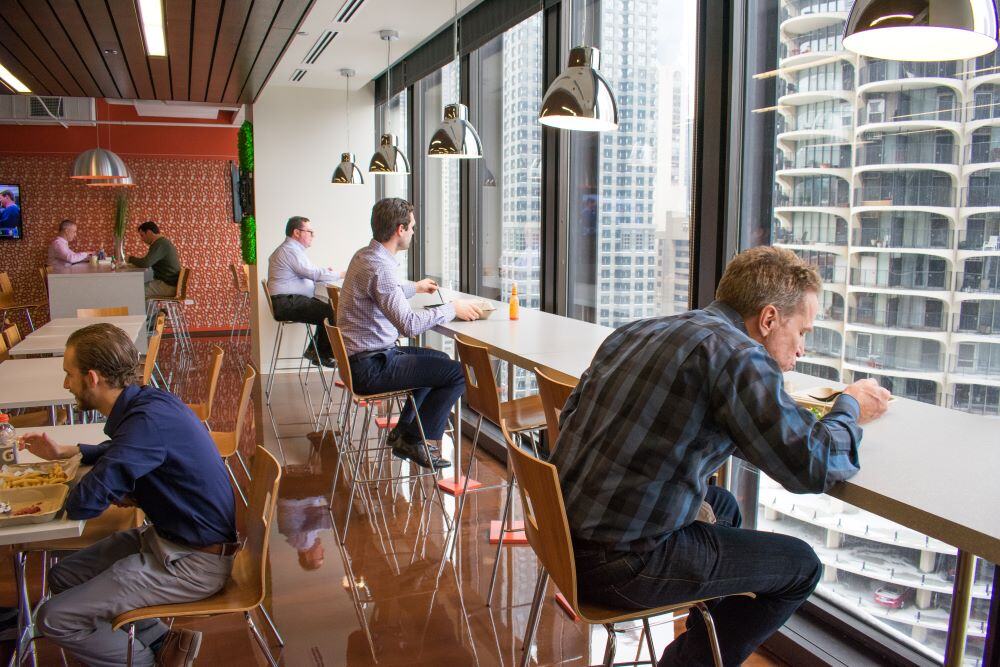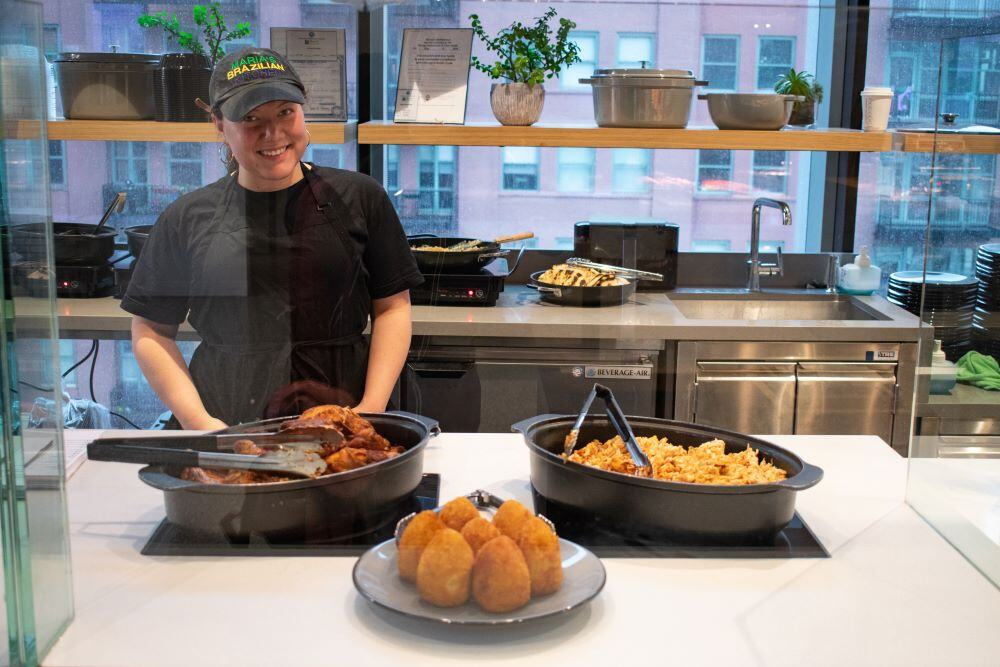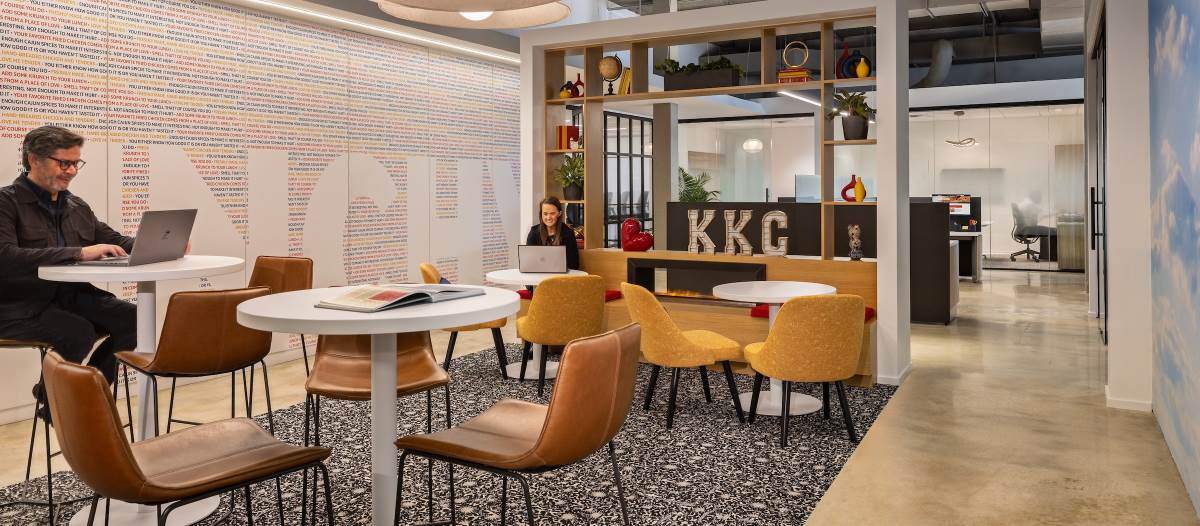Food for Thought
Installing pop-up food programs

Cafeteria replacement programs provide a cost-effective, all-in-one solution, enabling FMs to manage operations more efficiently and reduce overhead, such as infrastructure, staffing, technology and daily operations, as well as associated supply chain and inflationary cost increases. Typically, cafe programs include permanent local restaurant partners, such as a grill or salad station, and one or more local restaurants that change on a daily basis. These cafes often offer quick “grab and go” and snack items, as well.
Similarly, a pop-up food program, while streamlined and not as all-inclusive as a cafeteria replacement, offers the ability to provide meals from local restaurants in a breakroom or common area. These programs typically feature selections from a daily rotating roster of neighborhood eateries.

Return-to-work perks attract employees
According to Kastle Systems, overall weekly office occupancy remains around 51 percent, with peak attendance mid-week at about 60 percent and a drop to 33 percent on Fridays. This fluctuating attendance pattern highlights the need for facility managers to find innovative ways to encourage employees back to the office, especially on days with lower attendance.
A recent survey conducted by Fooda underscores the impact that pop-up restaurant meals can have on employee engagement. Its survey revealed that 81 percent of respondents indicated that the availability of food options in and around the workplace greatly influences their on-site attendance.
Benefits of pop-up lunch and cafeteria replacement programs include:
-
A small footprint: Pop-up food programs typically require minimal space, fitting into an area of about 12 feet by 7 feet. This small footprint makes them adaptable to various facility layouts, enabling even offices with limited space to offer diverse dining options. The flexibility in location setup ensures that the program can be integrated into different parts of the building, whether it is a lobby, break room or a designated dining area. Cafeteria replacement programs, on the other hand, use existing cafeteria facilities, while minimizing kitchen space used for prep work, cooking and storage.
-
Variety of food options: Cafeteria replacement programs offer the greatest variety of snack and meal options, with a selection of hot foods, grab-and-go items and a salad station offered by top-rated local restaurants. This variety allows for different dietary preferences and requirements, and it encourages employees to stay on site for lunch, fostering a sense of community and collaboration.
-
Easy management and maintenance: In most cases, local restaurants handle food preparation in their own kitchens, deliver the meals to the facility and clean up afterward. This minimizes the need for day-to-day management by the facility and helps to eliminate costs associated with unsold food. The convenience of not having to manage food preparation and waste disposal allows FMs to focus on other critical areas of building operations.
-
Menu and food partner flexibility: Some food program providers use sophisticated technology to gauge the popularity of specific menu items and overall food preferences. This allows for quick rotation of restaurant partners and menu choices, ensuring that dining options remain fresh and appealing and result in higher participation rates and an uptick in food sales.
-
Healthier choices: Providing healthy food options can lead to fewer lost workdays and better overall health, which is beneficial, given the high cost of health benefits for employers. Offering nutritious meals supports employee wellness initiatives and demonstrates a company’s commitment to the well-being of its workforce. A food program provider can ensure that restaurant partners are sensitive to a wide range of dietary needs and requests from employees by offering vegan, vegetarian and gluten-free entrees and snacks.
-
Company benefits options: Companies may choose to subsidize all or part of employee meals, which can be a significant perk. Rewards programs offered by food program providers also can provide employees with additional incentives for affordable in-house dining.
-
Fast and convenient checkout: Food program apps can facilitate the ordering and payment process, enabling employees to view menus, order in advance and make payments, providing lunchtime convenience for employees, saving time and enhancing the overall dining experience.
-
Community engagement: For employees, socializing with coworkers over lunch and interacting with restaurant staff fosters community ties and supports local businesses. Pop-up food and cafeteria replacement programs support neighborhood eateries and provide a platform for local restaurants to showcase and market their offerings. This synergy builds stronger connections between the workplace and the surrounding community.
-
Productivity boost: In areas with limited food options, pop-up food and cafeteria replacement programs enable employees to enjoy lunch within the building or office campus, reducing time spent away from the office. By eliminating the need to leave the premises for a meal, employees can maximize their break time and return to work feeling refreshed. This convenience can lead to increased productivity, as employees are less likely to be delayed by long lunch breaks or traffic.
-
Cost efficiencies: Cafeteria replacement and pop-up food programs can also eliminate prohibitive costs associated with delivery services for individual food orders. Bulk ordering and on-site dining reduce the expenses related to delivery fees and tips, making it a more economical option for both the company and employees. In addition, the streamlined logistics of these programs contribute to overall cost savings and operational efficiencies.

FM’s role
Onboarding new food programs: Transitioning to a new food program can take 60- -90 days, with the entire process spanning three to four months. The key to this transition is securing stakeholder agreement and alignment, with FMs playing the vital role in communicating the benefits of the new program to decision makers and gaining their support. Close consultation and collaboration with the food program provider can ensure a smooth transition and address any stakeholder concerns.
Implementation: FMs must coordinate with several departments to facilitate the food program transition, which may involve integrating new technology and security measures, and setting up the food program provider within the existing system. Depending on the current setup, the new provider also may be able to onboard personnel from the existing team.
Focus on core responsibilities: A cafeteria replacement or pop-up food program allows FMs to concentrate on other critical areas of a company or organization’s operations, such as maintaining the physical infrastructure and enhancing the overall workplace experience, while outsourcing the complexities of food service management. Cost management, technology, purchasing, menu selections, hiring, staffing, food safety and customer interaction could be handled by the program provider, depending on contractual details.
By adopting innovative food service solutions, facilities managers can create a more attractive and engaging workplace, encouraging employees to return to the office and enhancing overall productivity and satisfaction. Pop-up food programs offer a practical and cost-effective alternative to traditional cafeterias, providing a variety of dining options that cater to diverse tastes and preferences. These programs not only support employee wellness and community engagement but also contribute to operational efficiencies and cost savings.

Stafford McKay, vice president of marketing and communications at Fooda, is a seasoned marketing executive with a career spanning more than 15 years. Since the department’s inception in 2016, he has been at its helm, contributing to both B2B marketing and consumer growth strategies. McKay earned his Bachelor of Arts in international relations and German from the University of Massachusetts Amherst, and he furthered his studies in European and U.S. Foreign Relations at the University of Freiburg in Germany.
Read more on Occupancy & Human Factors , Real Estate and Workplace
Explore All FMJ Topics









